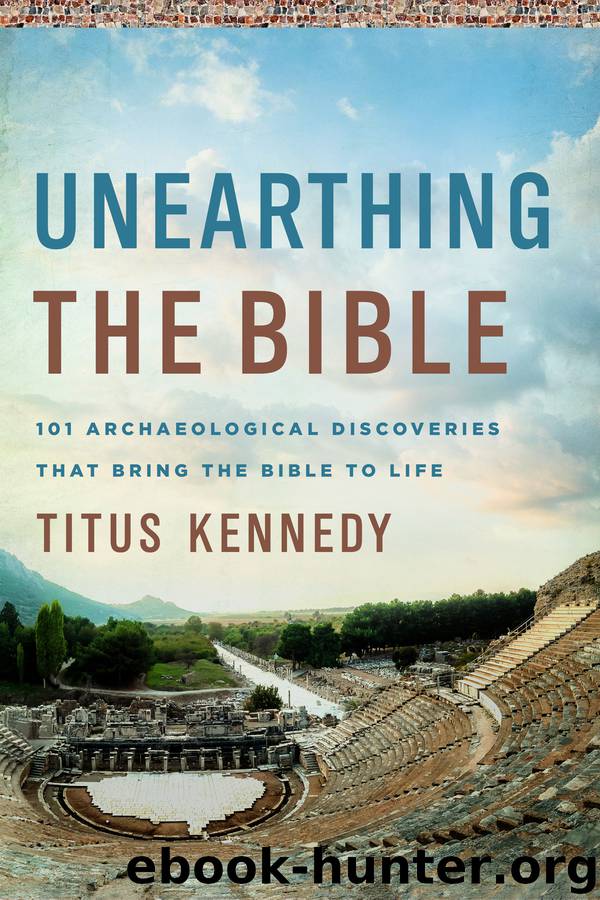Unearthing the Bible by Titus M Kennedy

Author:Titus M Kennedy
Language: eng
Format: epub
ISBN: 9780736979160
Publisher: Harvest House Publishers
Published: 2020-04-12T00:00:00+00:00
(52) THE LATRINE OF DESECRATION
(Iron Age Toilet Seat)
Date: 8th century BC
Discovered: Jerusalem, Israel
Period: Divided Kingdom
Keywords: Hezekiah; toilet; latrine; Jehu; desecration; pagan; ritual
Bible Passages: 2 Kings 10:18-28; 18:1-4; 2 Chronicles 31:1-2
Late in the reign of King Jehu of Israel, around 820 BC, Jehu destroyed the worshippers and the temple of Baal, the chief god of the Canaanite pantheon. As a specific act of desecration, Jehu broke down the temple of Baal in Samaria and “made it a latrine.” This temple of Baal in Samaria was probably adjacent to the palace complex built by Omri and Ahab.
Excavations of the Baal temple have not been undertaken, however, because the Roman period temple of Augustus was built over the likely location, and since it has been partially preserved over the centuries, the Augustus temple structure has been left intact.
Yet, a recent discovery at Lachish has uncovered evidence for the particular act of desecrating a pagan temple or shrine with a latrine during the kingdom period of Israel and Judah. At Lachish, a major ancient city in the kingdom of Judah, King Rehoboam had built a six-chambered gate and walls in the late 10th century BC, similar to those his father Solomon had built earlier. The fortifications, which were noted in the book of Chronicles and discovered in archaeological excavations at Lachish, continued to be repaired and used throughout the kingdom period. Inside the chambers of the gate, soldiers were stationed, merchants sold items, city elders judged, and a religious shrine was even set up. In one of the chambers, steps led up to a high place where an offering table and two horned altars were discovered.
This shrine at Lachish was in use during the 8th century BC until it was intentionally destroyed and desecrated during the reforms of King Hezekiah beginning around 715 BC, in which he had pagan altars, shrines, and idols destroyed. Artifacts discovered inside the shrine area included the “belonging to the king” stamp impressions on jar handles that date to the reign of Hezekiah, and another stamp impression with the text “belonging to Nahum, my servant” who was probably a royal official at Lachish.
When the order was carried out at Lachish, the reformers not only chipped the “illegal” horns off the altars, but a stone toilet seat was placed in the shrine, which was then sealed up and never again used. Tests on this toilet seat found no traces of fecal matter, demonstrating that it was a ritual toilet meant to convey a theological message and not one that had come from another structure or been used at another time.
The discovery of this latrine or toilet seat demonstrates the peculiar practice of ritual desecration of pagan temples and shrines by Israelite and Judean kings of the 9th and 8th centuries BC, recorded in the book of Kings, and adds further archaeological evidence to the spiritual reforms of Hezekiah found at several other ancient cities.61
They also broke down the sacred pillar of Baal and broke down the house of Baal, and made it a latrine to this day (2 Kings 10:27).
Download
This site does not store any files on its server. We only index and link to content provided by other sites. Please contact the content providers to delete copyright contents if any and email us, we'll remove relevant links or contents immediately.
The Five People You Meet in Heaven by Mitch Albom(2853)
Name Book, The: Over 10,000 Names--Their Meanings, Origins, and Spiritual Significance by Astoria Dorothy(2500)
Real Sex by Lauren F. Winner(2487)
The Holy Spirit by Billy Graham(2433)
The Secret Power of Speaking God's Word by Joyce Meyer(2264)
0041152001443424520 .pdf by Unknown(2230)
How The Mind Works by Steven Pinker(2228)
ESV Study Bible by Crossway(2146)
Ancient Worlds by Michael Scott(2113)
The Meaning of the Library by unknow(2079)
The Gnostic Gospels by Pagels Elaine(2041)
Churchill by Paul Johnson(2019)
MOSES THE EGYPTIAN by Jan Assmann(1981)
The ESV Study Bible by Crossway Bibles(1964)
Jesus by Paul Johnson(1895)
Ancient Near Eastern Thought and the Old Testament by John H. Walton(1857)
The Nativity by Geza Vermes(1855)
The Complete Dead Sea Scrolls in English (7th Edition) (Penguin Classics) by Geza Vermes(1852)
City of Stairs by Robert Jackson Bennett(1842)
